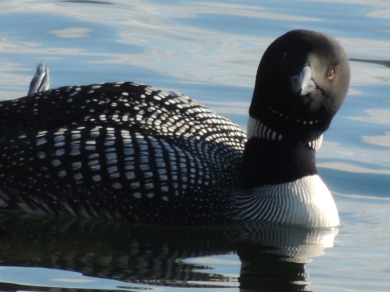Last week, Chris Rimmer and I traveled to Lake Willoughby to meet with Carol Radic and Colm Darcy, who helped me rescue a loon entangled in fishing gear back in July of 2011. I banded this bird before releasing it, and Carol and Colm have observed it every summer since. Carol “told” the loon to show up for us last week, and sure enough, it drifted by close enough for Chris to observe the color bands underwater.
Three years after we banded it, this loon continues to occupy the same section of Lake Willoughby shoreline. I would think that the bird (a probable male by size) would be seeking a breeding territory on a nearby lake with suitable nesting habitat, such as Long or May Pond. Lake Willoughby has no marshes or islands, and no known history of loon nesting. A big question for me is why this loon remains in the same area year after year? Very little is known about non-breeding loons, including where they live during the summers prior to establishing a territory. Most information comes from Dr. Walter Piper’s research following banded chicks that return as adults, and where they acquire territories. (See the 2014 Loon Caller newsletter for a story about some of Piper’s findings).
This loon obviously uses Lake Willoughby as its summer residence. The bird appears to concentrate on only one section of the lake near Carol and Colm’s camp, using it effectively like a breeding territory, but without a mate, or nesting. We’ve observed yodeling and other territorial–like behaviors on other large, non-breeding lakes, indicating that these unpaired loons are defending some kind of resource (e.g., feeding and resting areas). The banded Willoughby loon may in fact be investigating nearby breeding lakes, biding its time for an eventual takeover challenge while it uses Lake Willoughby as a secure spot to live. The availability of large lakes that lack active breeding territories may be an important resource for non-breeding loons as they prospect for mates and territories.
We may never know the answer to some of these questions, but it’s amazing to think that this individual loon keeps returning to the very spot where we rescued it. It’s irresistibly tempting to suspect that the bird might be offering a “thank you”, in its own way.
Eric Hanson, Vermont Loon Conservation Project


Thank you so much for this article.
We have had a loon pair on our lake for the last 20 years. Most years they mate, nest and have chicks.
We realize these are not the same loons year after year but there was a banded pair for a few years.
Last year the pair we had failed after three tries to have a nest. Eagles are a problem here.
This year we have a single loon that comes and goes from our lake. We thought we had a mated pair but there was no nesting activity. Black flies were a problem again here.The second loon just up and disappeared after a few weeks.
So I am now assuming the loon we have has claimed the lake as his territory and the female was lost or just left. I hope we have better luck next year.
Hi April,
Spots in territories open up when a single loon moves to a different lake or dies. Usually, a new bird shows up and pairs with the remaining adult without us ever noticing it. Based on work by Dr. Walter Piper in Wisconsin following banded loons, the average pair lasts from 3-5 years before there is a change in one of the birds, usually not both. However, some pairs will stay together for 10-20 years if all goes well for them. I’m finding in Vermont, that pairs might dissolve (start seeing only a single loon for a summer) on more marginal territories (small, shallow lakes, lakes with minimal nesting sites). It’s rare to see a pair disappear on larger lakes. Pairs often do not nest if there is continued territorial battles, changes in water levels, or changes in mates. Eagle presence might influence whether a pair nests, but I’m not sure if this has really been documented/observed. Wisconsin saw almost all nests in May abandoned this year because of black flies. I think this occurs less frequently in the northeast.